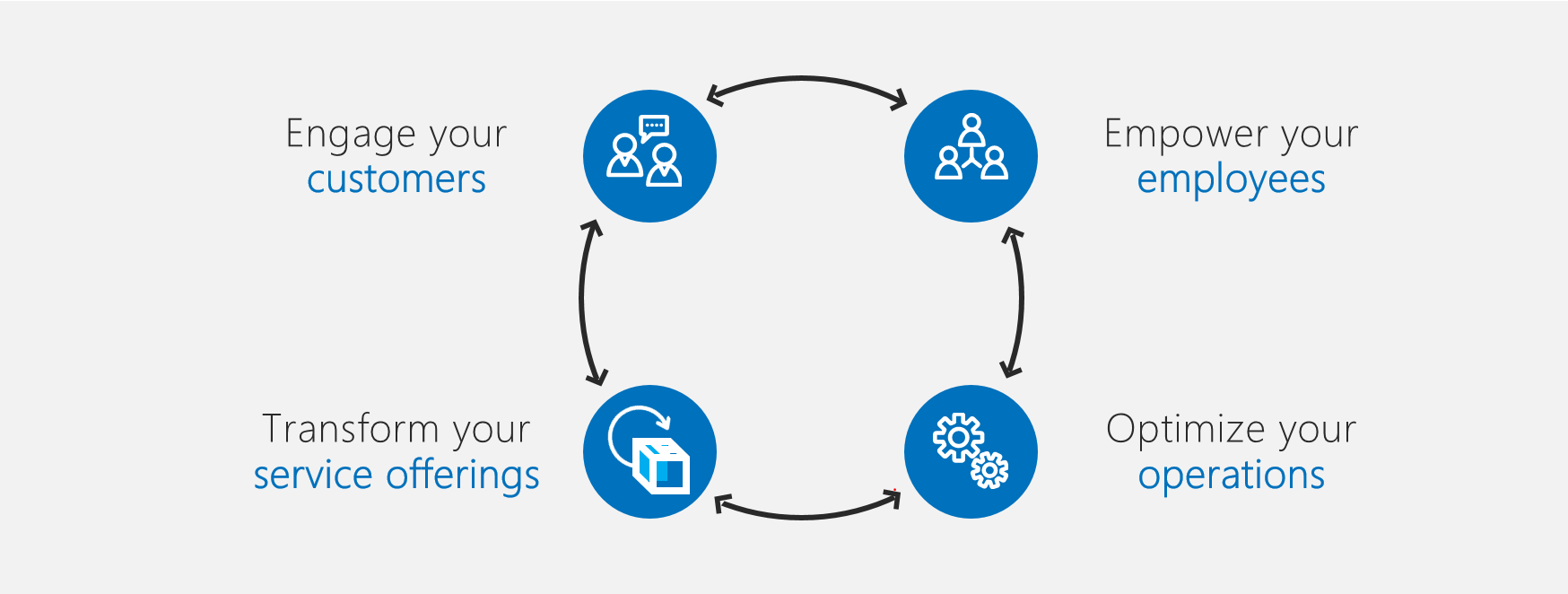Digital transformation is not about replacing or refreshing your CRM or ERP...
It isn’t about corporate restructuring or starting over...
It’s about evolution. It’s about transforming your business from the inside out, and being able to do so at scale.
Some businesses are looking to improve their profitability, others to increase operational efficiency, while others want to explore new markets.
There are infinite ways to tackle the digital dares that are hindering your organization’s digital transformation. Microsoft’s approach is a simple and comprehensive roadmap that focuses on four key pillars. It allows organisations to easily identify the right business objectives and build a plan or a roadmap to achieve concrete results.

1. Empower your Employees
Foster collaboration, fuel productivity and maximize mobility to attract and retain top talent, while mitigating risks that come with providing freedom and space to employees.
Implementing a digital culture means maintaining a forward-thinking vision and empowering your team with the best tools to simplify collaboration and improve productivity.
Your employees are already using everyday productivity tools like Word, Excel, Outlook and PowerPoint. So, a logical first step is to digitally-empower them by bringing all these familiar tools into the cloud with Office 365 and add apps like OneDrive, SharePoint, Teams and Skype for real-time collaboration, mobility and knowledge sharing.
2. Engage your customers
Build better, stronger engagements by harnessing data representing a 360-degree view of your customer, then drawing actionable intelligence and predictive insights that can deliver personalization at every touchpoint.
A key benefit of digital is the possibility to track, measure and report on every single customer activity and action. For example, business intelligence is infused in all Microsoft solutions, so you can visualize relevant data and KPIs in customizable dashboards and monitor the real-time performance of your digital business. The power of this 360-degree view of your business and your customers brings to light all the ways you can optimize experiences to be more personalizedꟷ and more profitable.
3. Optimize your operations
Optimize operations to reshape customer relationships and service models by gathering data across a wide, dispersed set of endpoints, and drawing insight through advanced analytics that can be used to introduce improvements on a continuous, real-time basis.
SaaS (Software as a Service) and consumption-based models for modern infrastructures are now more conventional (and wiser) ways of buying technology.
A perfect example is the realization of Dynamics 365 , Microsoft’s powerful SaaS integrating CRM and ERP into one service to provide end-to-end business functionalities: Sales, Marketing, Finance, Project Service Automation, Customer Service, Operations, Field Service.
These models and concepts not only lower initial capital investments, they also increase the agility to change if and when needed.
4. Transform your products
Reinventing products, services and business models using digital content to capitalize on emerging revenue opportunities.
New players focusing on new consumer behaviours and expectations are changing the game, leveraging digital and technology to disrupt established business models.
To keep up with these digital-first companies, businesses need to adapt not only their technology but also their existing business models and offerings, finding ways to differentiate with new products and services.
Without the right technology foundation and agility to evolve as business needs change, it will become increasingly difficult to meet new demands and retain customers in a competitive market.
This four-pillar approach is proven to support small, medium and large enterprises in their digital transformation.
First, find the best team of experts to help build your roadmap and identify key priorities. You don’t need to tackle everything at once.
Then, ensure you invest in a modern technology framework as your foundation that enables agility and growth.
With these key pieces in place, your digital transformation journey will naturally start exactly where you are now and evolve as your business needs change.